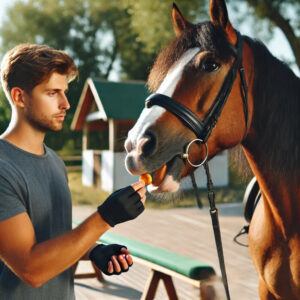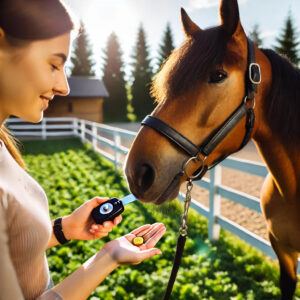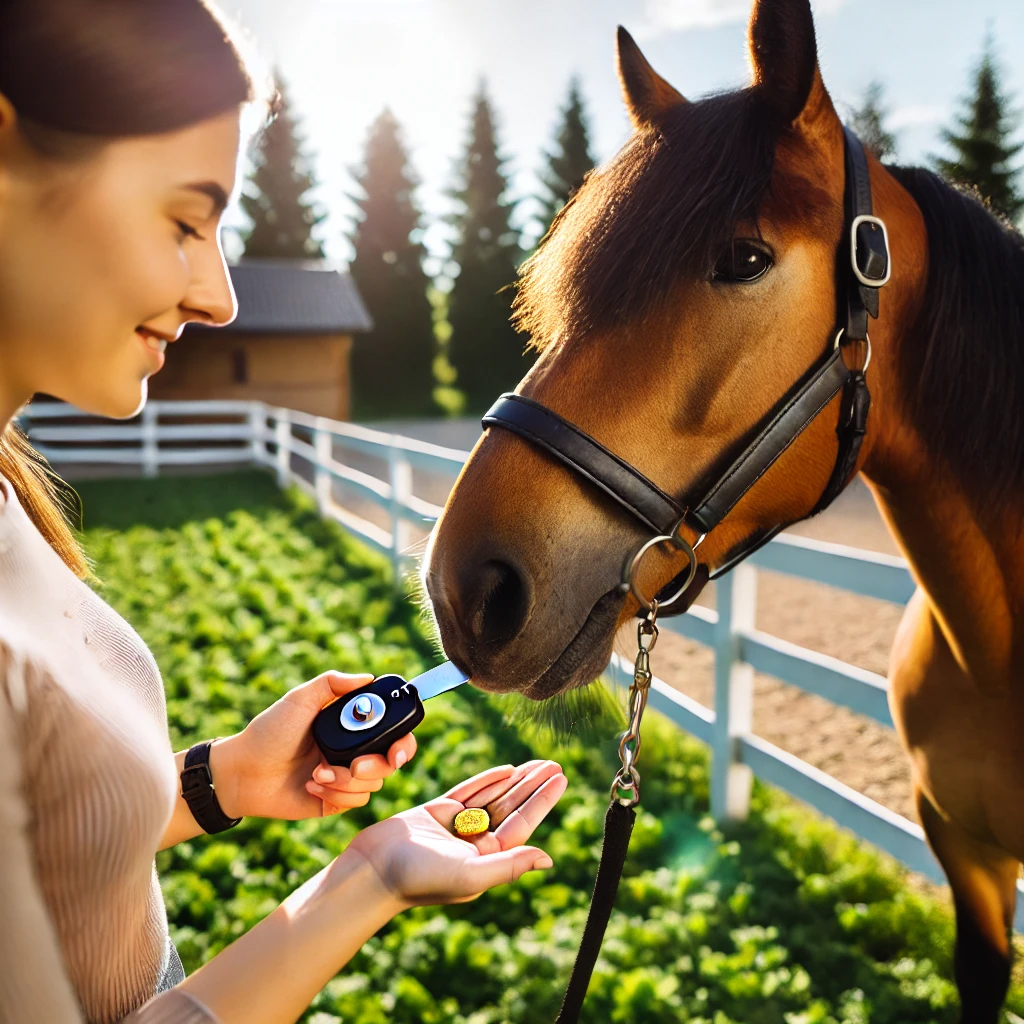
Reward-based training is about teaching horses using positive reinforcement. Think of it as rewarding good behavior rather than punishing bad behavior. This method has been around for a while but has gained more love and attention only recently, especially as people become more aware of the welfare and mental health of animals.
I think of it kind of like when I trained my dog to go potty outside. We would use treats to reinforce the good behavior of going outside to do her business.
Historically, training horses often involved methods that could be quite harsh and unforgiving. Traditional techniques sometimes relied heavily on pressure, fear, and even pain. Luckily, we’ve evolved! Reward-based training emerged as a breath of fresh air, focusing on the positive aspects of training rather than negative reinforcement.
So, why does reward-based training win gold stars in the humane department? It’s simple. This technique lets horses learn without fear or stress. When horses associate training with nice things like treats, praise, or a good scratch at their favorite spot, they’re more likely to enjoy the process and engage willingly.
Reward-based training isn’t just about being nice. It’s also incredibly effective. A horse that’s keen and motivated because it knows a reward is coming will likely learn faster and more reliably. Plus, the bond between the horse and trainer grows stronger as they work together in a positive atmosphere.
Stick around as we break down the essential parts of these techniques, guide you through the steps, tackle common hurdles, and chat about the benefits and ethics involved. It’s rewarding for both horse and human.
Key Components of Reward-Based Training Techniques

Positive reinforcement is at the heart of reward-based training. It involves giving the horse a reward immediately after it performs the desired behavior. Timing here is everything; give that carrot or pat right away so the horse links the reward with the action.
When it comes to rewards, variety can be your best friend. Food treats are a common favorite – think carrots, apples, or special horse treats. But it doesn’t have to be all about food. Praise, a gentle rub, or even playtime can be just as effective. Every horse has its own preferences, so it’s important to figure out what motivates your horse the most.
Another crucial element is timing and consistency. Rewards should be given immediately after the behavior you want to reinforce. This helps the horse make a clear connection between what it did right and the good thing that followed. Being consistent makes sure you’re sending the right messages every time. Mixed signals can confuse the horse and slow down the training process.
 Clicker training is a popular technique within the realm of positive reinforcement. A small, inexpensive clicker can be a powerful tool. The click sound tells the horse exactly when it did something right, followed by a reward. It creates clear communication and can speed up learning. If a clicker isn’t your thing, a verbal cue like a simple “Good!” can also work well.
Clicker training is a popular technique within the realm of positive reinforcement. A small, inexpensive clicker can be a powerful tool. The click sound tells the horse exactly when it did something right, followed by a reward. It creates clear communication and can speed up learning. If a clicker isn’t your thing, a verbal cue like a simple “Good!” can also work well.
Understanding your horse’s individual personality and comfort level is key. What works for one horse might not work for another. Some horses might be food-driven, while others might crave attention or play. Observing your horse and experimenting with different rewards will help you find the winning formula.
It’s important to set short and achievable goals. Don’t rush the training. Start with simple tasks and gradually increase the difficulty as your horse becomes more confident. Patience is your best tool here. Trying to force progress too quickly can lead to frustration for both you and your horse.
Implementing Reward-Based Training with Horses
Starting with reward-based training doesn’t have to be daunting. Begin with simple, straightforward tasks that set your horse up for success. For instance, you might start by teaching your horse to come when called. Every time the horse responds correctly, immediately reward it with something it loves—a treat, praise, or a good scratch. This positive experience will build a solid foundation for more complex tasks.
One common challenge you may face is the horse not understanding what’s expected. If this happens, break the task down into smaller, manageable steps. Reward any small progress to keep the motivation high. If the horse seems frustrated or confused, take a break or switch to an easier task before returning to the challenging one.

Body language is a key tool in horse training. Horses are incredibly perceptive and can read our body cues extremely well. Make sure your body language is calm, confident, and consistent. Mixed signals can confuse the horse and slow down the training process. Always be aware of how you’re presenting yourself to the horse, and make sure your cues are clear and consistent.
Let’s talk about patience, which is crucial. Training is a journey, not a race. Some days will be better than others, and your horse might not always perform perfectly. That’s okay. Celebrate the small victories and remember that setbacks are part of the learning process for both you and your horse.
Sharing real-life success stories can be a great way to stay motivated and inspired. Many trainers have transformed their relationships with their horses using these methods. For example, there’s the story of a once-skittish mare who learned to trust her handler through consistent reward-based training. Over time, this horse went from avoiding human contact to confidently accepting the saddle and bridle. These stories remind us that with patience and positive reinforcement, real progress is achievable.
Benefits and Ethical Considerations
Reward-based training isn’t just a humane approach—it’s packed with benefits for both horse and trainer. Physically, it promotes a healthier, stress-free lifestyle for your horse. When they aren’t subjected to harsh training methods, horses can remain more relaxed, which is crucial for overall well-being.

Psychologically, the benefits are equally impressive. Reward-based methods can boost a horse’s confidence and willingness to learn. A horse that eagerly participates in training sessions is a joy to work with and typically learns faster and retains lessons longer. This boosting of trust and confidence can’t be underestimated.
Ethically, this approach respects the horse’s nature. Horses are intelligent and sensitive creatures. Training them using rewards rather than punishments aligns better with their natural behaviors and social structures. It’s all about building a partnership based on trust rather than fear. The respect and mutual understanding that grow from this method are invaluable and can significantly enhance the horse-human relationship.
Comparing reward-based training to traditional methods offers a clear view of why positive reinforcement is preferred by many modern trainers. Traditional methods often rely on fear and pressure, which can strain the horse’s mental and physical well-being. Reward-based training, however, encourages a positive learning environment that’s enjoyable for the horse. The contrast is striking and highlights why positive reinforcement is gaining popularity.
Seeing these benefits and ethical considerations come to life in real-world training can be extremely convincing. Watching a previously wary horse develop confidence and competence through reward-based methods is inspiring. It’s not just about teaching a task but nurturing a happy, enthusiastic learner. This holistic, positive approach to training enriches the lives of both horses and their humans, creating a lasting bond grounded in respect and trust.

